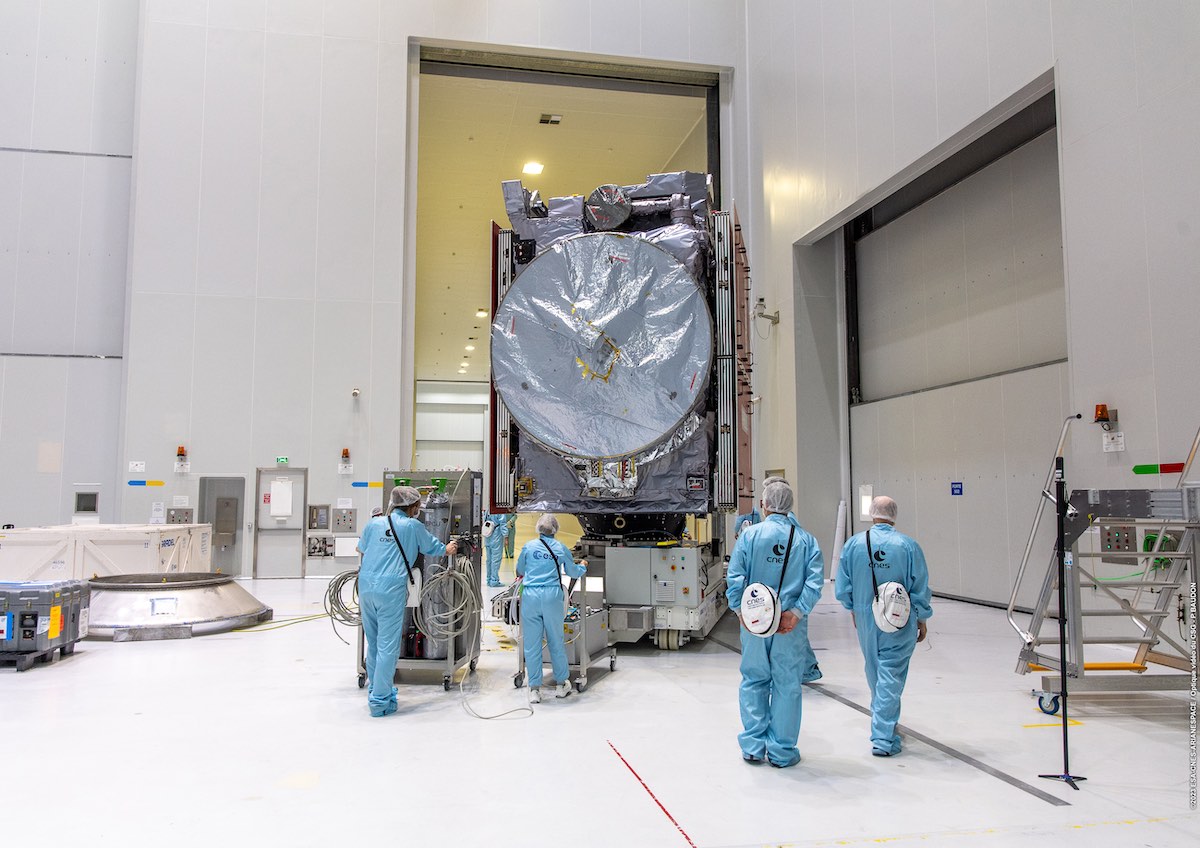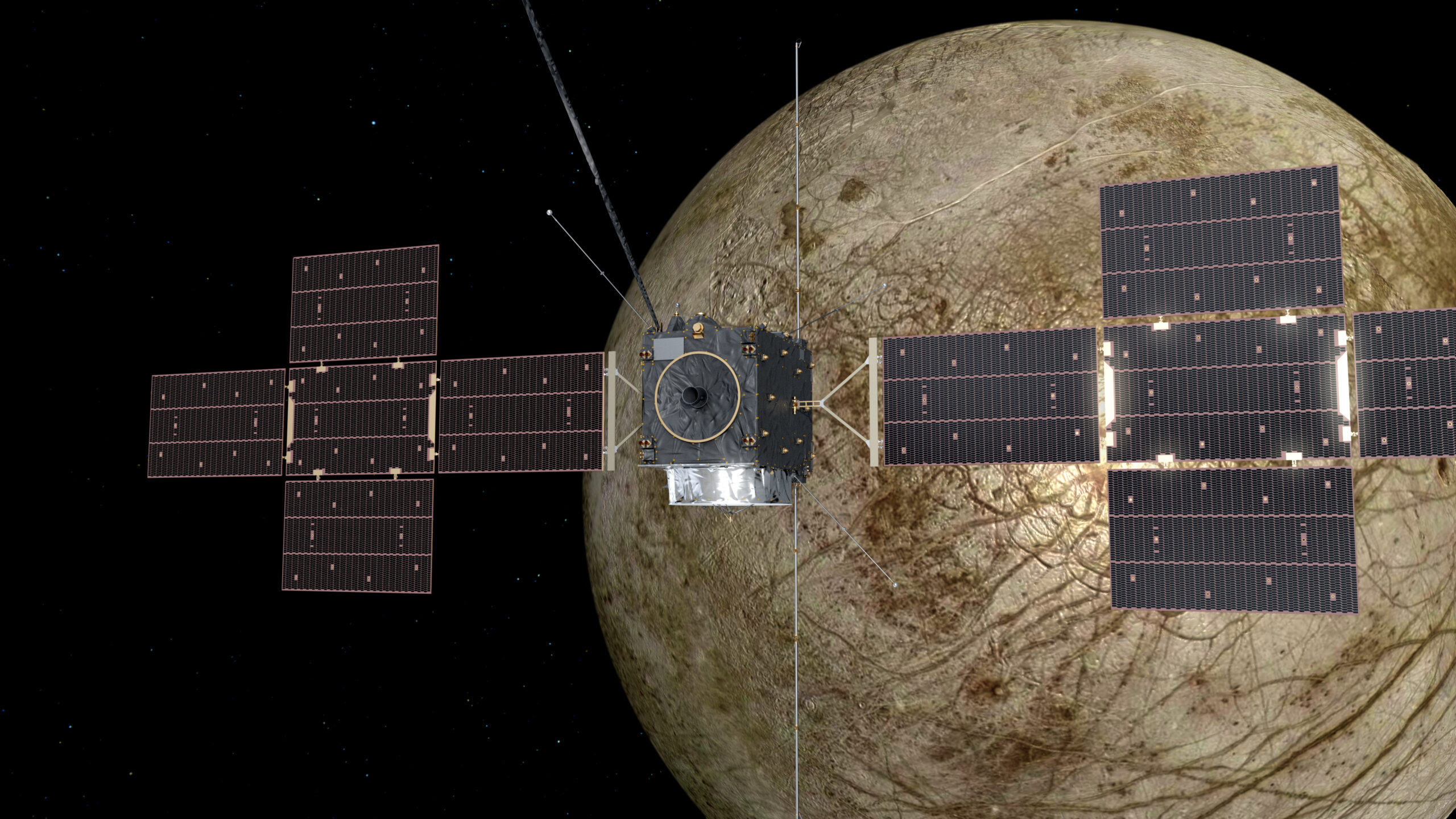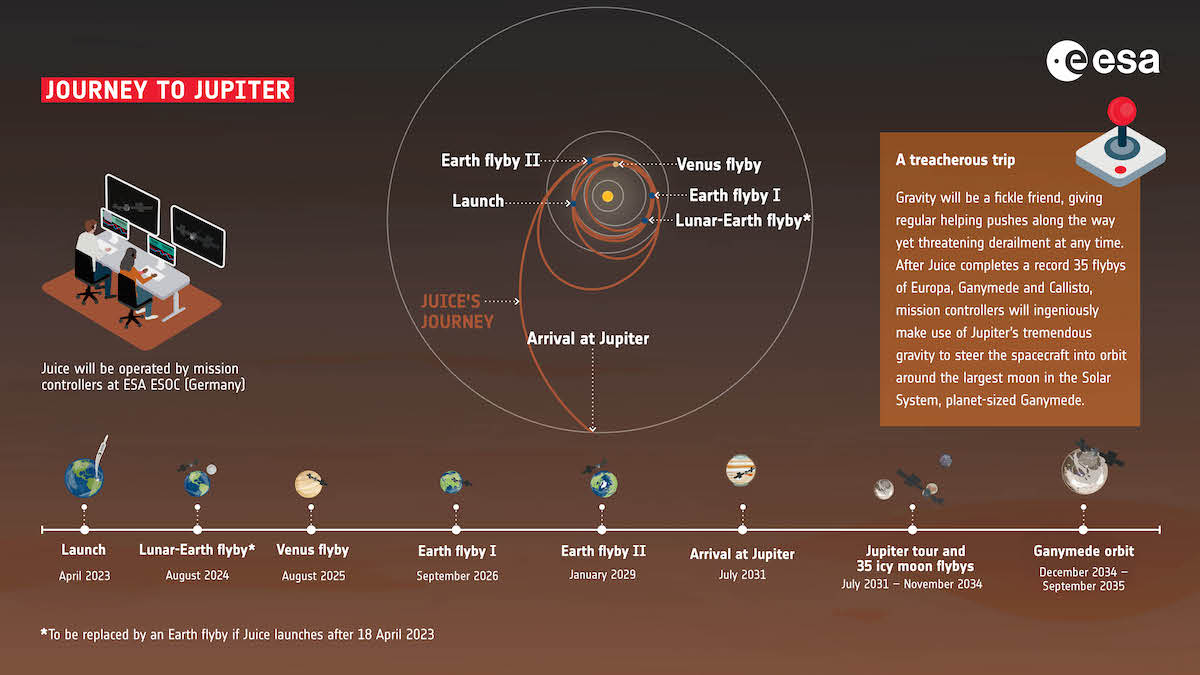
An Ariane 5 rocket took off from French Guiana Friday with the heaviest interplanetary science probe ever launched, kicking off a $1.7 billion European Space Agency mission on a decade-long quest to Jupiter’s icy moons in search of environments that could be habitable for life.
The Jupiter Icy Moons Explorer mission took off at 8:14:36 a.m. EDT (1214:36 UTC; 9:14:36 a.m. French Guiana time) to begin an eight-year cruise to the solar system’s largest planet. The mission, known as JUICE, will enter orbit around Jupiter for a series of flybys of three of the planet’s largest moons, then will make history by becoming the first-ever spacecraft to orbit one of Jupiter’s moons in the mid-2030s.
JUICE carries a high-resolution camera and ground-penetrating radar to map the frozen landscapes of Ganymede, Callisto, and Europa, along with a suite of spectrometers to measure the composition of their icy crusts. After launch, the JUICE spacecraft will deploy an insect-like array of antennas and booms with sensors to study particles and dynamic plasma fields around Jupiter and its moons.
The 13,141-pound (5,961-kilogram) JUICE spacecraft rode into space aboard the Ariane 5 rocket for nearly 28 minutes, getting enough of a velocity boost to escape Earth’s gravity and head off into the solar system. After separating from the Ariane 5’s upper stage, JUICE contacted a ground station and unfurled its two power-generating solar array wings, each arranged in a distinctive cross-like formation.
We have a mission! We are flying to Jupiter,” said Andrea Accomazzo, operations director at the ESA control center in Darmstadt, Germany. “We go there fully loaded with questions.”
The solar panels are the largest ever built for an interplanetary spacecraft, stretching nearly 89 feet (27.1 meters) tip to tip with an area of 915 square feet (85 square meters). Their large size will allow JUICE to produce enough power for the spacecraft and its science instruments at Jupiter, around five times farther from the sun than Earth. The spacecraft’s 23,560 solar cells will generate 850 watts of power.
According to ESA, JUICE’s solar arrays could power an entire road of houses when collecting solar energy near Earth. At Jupiter’s distance from the sun, the solar panels could only power a single microwave.
Liftoff of the Ariane 5 rocket from French Guiana with Europe’s Jupiter Icy Moons Explorer, or JUICE, mission.
JUICE is kicking off an eight-year interplanetary journey to explorer Jupiter and three of its largest moons.https://t.co/FZ6eqEewD2 pic.twitter.com/vzYzNhpEJc
— Spaceflight Now (@SpaceflightNow) April 14, 2023
“We’ll explore Jupiter and its icy moons, which are Europa, Ganymede and Callisto, with a particular focus on Ganymede, which is a unique object in the solar system, the only moon with a magnetic field and the biggest moon of the solar system,” said Olivier Witasse, project scientist for the JUICE mission at the European Space Agency. “The main goal is to understand whether there are habitable environments among those icy moons around a giant planet like Jupiter.”
Scientists believe Europa, Ganymede, and Callisto harbor oceans of liquid water beneath their icy crusts.
“We will characterize, in particular, the liquid water oceans which are inside the icy moons,” Witasse said. “So the question is, where are those oceans located, at which distance underneath the surface of the moons, what is the depth of this ocean? How much water do we have? What is the composition of this water?”
Built by Airbus, JUICE has 10 science instruments developed by research teams across Europe, the United States, and Japan. According to ESA, the mission is outfitted with “the most powerful remote sensing, geophysical, and in situ payload complement ever flown to the outer solar system.”
An Italian-led radar sounder will probe the icy crust covering Jupiter’s moons, revealing structures as deep as 6 miles (9 kilometers) under the surface. JUICE’s main camera will take pictures of Jupiter’s cloud patterns, rings, and the chaotic and cratered terrain of Europa, Callisto, and Ganymede.
“To understand this question of habitability, we need to explore the Jupiter system globally,” Witasse said. “So to study Jupiter, its atmosphere, its weather, its strong rotating magnetic field, the volcanic moon Io, the other moons in the system, and how all these bodies are connected to to each other.”

The launch of the JUICE mission Friday occurred a day later than planned. Officials called off a launch attempt Thursday due to the risk of lightning at the launch base in French Guiana.
But weather conditions were acceptable Friday morning, and the Ariane 5 lit its hydrogen-fueled main engine and two solid rocket boosters to power off the launch pad with 2.9 million pounds of thrust. An upper stage did the final work of propelling the JUICE spacecraft on a trajectory to take it into the solar system.
“This is something that I think Europe can be extremely proud of,” said Josef Aschbacher, director general of ESA. “Extremely proud because because this is a mission that is answering questions of science that are burning to all of us.
“Of course, one of these questions is is there life out there? JUICE will not find life, I have to be very clear, but JUICE will be identifying the habitability of these icy moons of Jupiter. This is a very important mission for all of us, for all mankind, is life possible and what would be the habitat where life could exist?”
The spacecraft’s first 17 days after launch will include a series of instrument, antenna, and boom deployments.
“JUICE is a spacecraft has taken the better part of the past decade to be designed and developed, and is now ready for launch on top of the Ariane 5 launcher,” said Alessandro Atzei, ESA’s payload system engineer for the JUICE mission. “So we’re talking about rather large spacecraft with many key features that really are striking. The very large high gain antenna, the huge solar arrays, 85 square meters, and many, many deployable booms. So just after launch, it will be a lot of work to make sure that everything gets deployed properly so we can start our mission.”
ESA selected the JUICE mission for development in 2012, beating out proposals for an X-ray astrophysics observatory and a gravitational wave detector mission in a competition for funding in the agency’s Cosmic Vision space science program.
Despite a big boost from the Ariane 5 rocket, the JUICE spacecraft will not take a direct route to Jupiter. It will circle the sun one time before returning for a flyby of the Earth and the moon in August 2024, a maneuver to use gravity to begin reshaping the probe’s orbit. The flyby will be the first time a spacecraft performs a gravity assist maneuver with both the Earth and the moon.
A similar gravity assist flyby with Venus is scheduled in August 2025, followed by two more Earth flybys in 2026 and 2029. In a make-or-break moment for the mission, JUICE will fire its main engine to be captured into orbit by Jupiter’s gravity in July 2031. That milestone will begin a series of 35 flybys of Ganymede, Callisto, and Europa, making precise measurements of the thickness of Europa’s global ice sheet and searching for organic molecules.
“Jupiter, it’s really a miniaturized solar system,” Witasse said.
Then, in 2034, JUICE will maneuver into orbit around Ganymede itself for a detailed survey.
The spacecraft will attempt to confirm the existence of a deep subsurface ocean on Ganymede. A laser altimeter instrument primarily funded by Germany will measure tidal deformation to help scientists learn more about Ganymede’s hypothesized internal ocean, and gather data for a global topographic map of the solar system’s largest moon.
JUICE’s instruments will create a high-resolution map of its icy surface, and investigate Ganymede’s magnetic field. When JUICE runs low on fuel, ground controllers will guide the spacecraft on a collision course with Ganymede to ensure it doesn’t contaminate any other moons in the Jupiter system, which could hinder future missions searching for life.
Many of JUICE’s goals follow up on discoveries made by NASA’s Galileo mission, which toured the Jupiter system from 1995 to 2003.
The JUICE mission won’t be alone at Jupiter. NASA plans to launch its own multibillion-dollar Jupiter-bound spacecraft, Europa Clipper, from Kennedy Space Center in Florida in October 2024.
Europa Clipper will launch on a more powerful rocket, SpaceX’s Falcon Heavy, and arrive in orbit around Jupiter in April 2030, a year ahead of JUICE. The two missions are complementary, with JUICE focused on Ganymede and Europa Clipper primed to study Europa, one of the best candidates for a habitable world elsewhere in the solar system.
“Jupiter, it’s really a miniaturized solar system,” Witasse said.

Scientists in the United States and Europe are investigating opportunities for coordinated observations between the Europa Clipper and the JUICE spacecraft.
“We have studied the two trajectories in the system, and we can see that we can do great science at Europa, when the two spacecraft can observe this moon together,” Witasse said. “One example would be a flyby of Clipper, followed by the flyby of JUICE just four hours later.”
Another robotic mission currently orbiting Jupiter is NASA’s Juno spacecraft, which arrived at the gas giant in 2016 and has now completed 50 orbits around the planet. Juno’s scientific payload is designed to study the atmosphere and internal structure of Jupiter, but scientists have recently expanded the scope of the mission to image Jupiter’s largest moons.
Europa Clipper and JUICE will become the third and fourth spacecraft to orbit Jupiter, following a series of one-shot flybys that began with NASA’s Pioneer 10 and 11 probes in 1973 and 1974.
The JUICE spacecraft’s sensitive avionics are contained within a lead-lined vault to shield them from the harsh radiation around Jupiter.
“Mass, power, everything is really optimized for these sorts of missions,” said Justin Byrne, head of science programs at spacecraft builder Airbus Defense and Space. “The radiation is a killer for the electronics, and unless you protect it, the electronics will start failing. We would have memory corruptions and then catastrophic failure of the computers eventually.”
JUICE will head deeper into the cosmos than any European spacecraft has ever gone on its own. ESA’s Huygens probe, which landed on Saturn’s moon Titan, hitched a ride to Saturn with NASA’s Cassini spacecraft.

The JUICE spacecraft was designed with redundancy, with two computers and backups for most major systems, according to Byrne.
“In addition, because Jupiter is a long way away, we can’t directly control it,” Byrne said.
It takes about an hour-and-a-half for radio signals to make the round-trip journey between Earth and Jupiter. That required engineers to design the JUICE spacecraft with autonomous software to detect problems and put itself into a safe configuration long enough to await commands from controllers back on Earth.
JUICE’s 8.2-foot-wide (2.5-meter) high-gain antenna will beam imagery and science data back to Earth. Scientists at research institutions around the world will analyze the measurements.
“We are not going to detect life with with JUICE,” Witasse said. “But nevertheless we are going to study interesting aspects related to life and habitability.”
An ion mass spectrometer on JUICE will measure water vapor and other molecules in the tenuous atmospheres of the icy moons. Another instrument will measure vertical profiles of the moons’ atmospheres.
“Really, the most interesting aspect of of the mission to know where is this water?” Witasse said. “What is the composition in terms of salt? How does that relate to the habitability of those moons?”
Email the author.
Follow Stephen Clark on Twitter: @StephenClark1.
from Spaceflight Now https://ift.tt/gJYcj7i
via World Space Info







0 comments:
Post a Comment